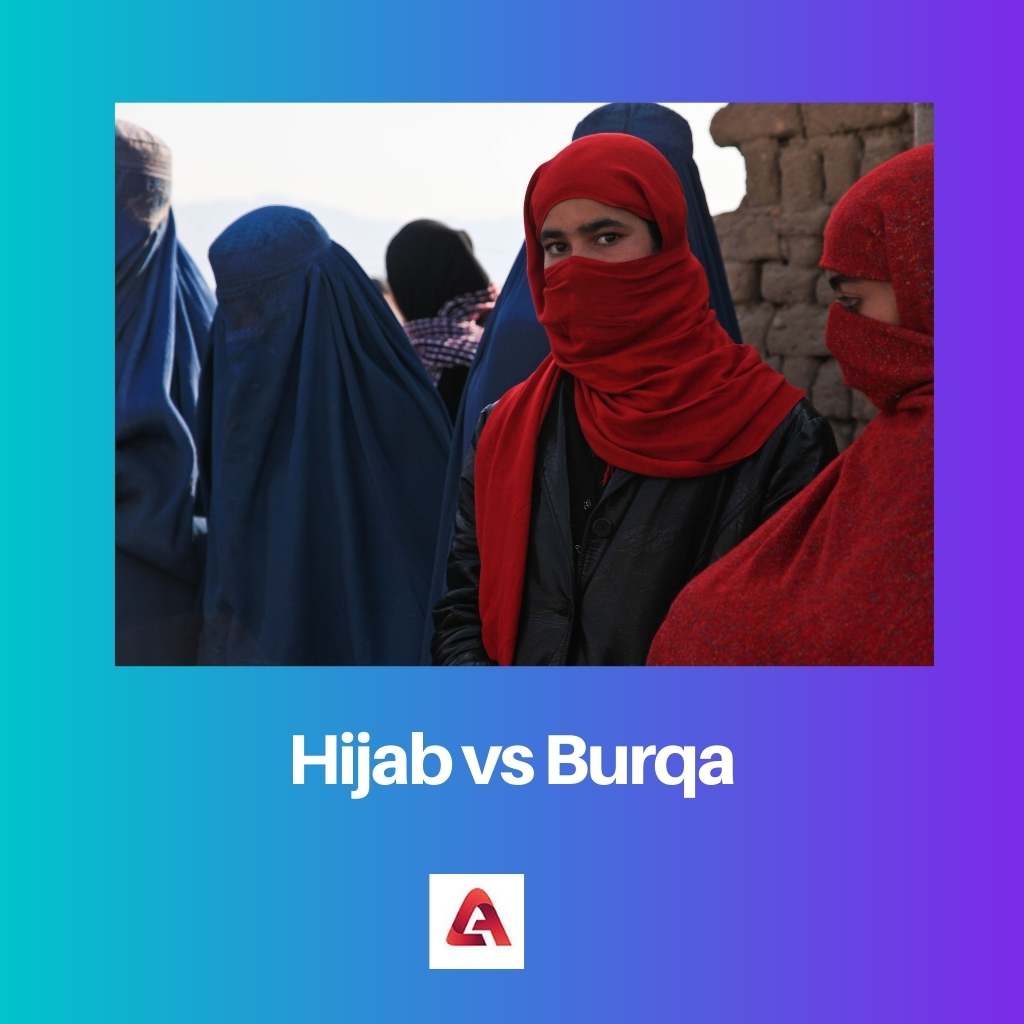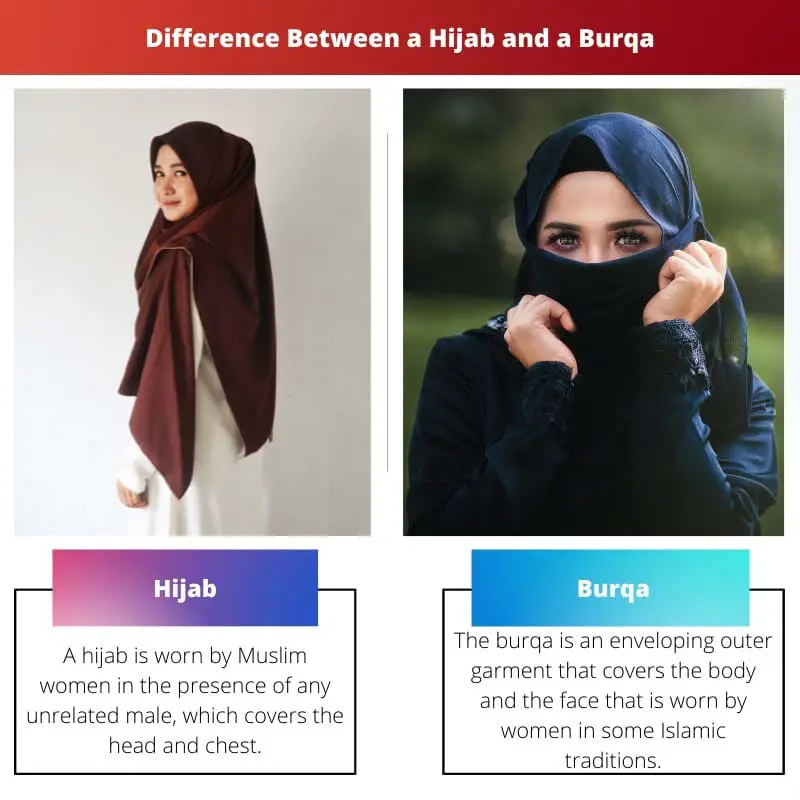Hijab and Burqa are women’s wear of the same are not. Some are proud to represent Islam or dress in it because they want their husbands to be more open about them wearing full veils when travelling together.
Others feel that religion only promotes social acceptance for those who choose to remain veiled, not religious tolerance itself.
Key Takeaways
- A hijab is a headscarf that covers a woman’s hair and neck, while a burqa is a full-body covering with a mesh screen for the eyes.
- Hijabs are widely worn in Muslim-majority countries, while burqas are more specific to certain regions, such as Afghanistan and parts of Pakistan.
- The hijab provides modesty while allowing the face to be visible, whereas the burqa covers the entire body, including the face.
Hijab vs Burqa
The difference between a Hijab and a Burqa is that a Hijab is a headscarf, but a Burqa is a veil. The hijab covers ears, hair, and neck, but the burqa hides the head and body. Burqa has grills in front of the eyes, but Hijab has no grills. The hijab shows a face, but the burqa does not show a face.

Muslim women wear a hijab in the presence of any unrelated male, which covers the head and chest. The Hijab is a veil. Muslim women wear Hijab to maintain privacy from unrelated male of the society.
The Islam body bans the wearing in public premises of any symbol or image (of any sort) that implies authority.
The burqa is an enveloping outer garment that covers the body and face worn by women in some Islamic traditions.
Scholars from various schools of have argued it thought that this covering may serve as protection against sexual abuse, particularly when combined with a headscarf or veil.
Comparison Table
| Parameters Of Comparison | Hijab | Burqa |
|---|---|---|
| Type | Headscarf | Veil |
| Covers | Hairs, ears, and neck | Head and body |
| Face | Visible | Not visible |
| Grills | No | Yes |
| Where | Islamic countries | Afghanistan |
| Urban areas | Yes | Rarely used |
What is a Hijab?
A hijab could be a veil worn by certain Muslim women within the presence of any male outside their immediate family, which covers the pinnacle and chest.
It was banned from public spaces for 2 months after President George W Bush’s 2003 National Security Action Memorandum on “Defense against Al-Qaeda” said it violated a private or business’ rights to freedom in the slightest degree.
Muslim women wear the Hijab to take care of modesty and privacy from unrelated males. Women wear hijabs at least several times, even after not wearing a veil (as seen in the photo).
Women wear Hijab (a head covering) while walking, in public, working, or at home.
It’s worth noting that the video isn’t entirely clear whether it had been of a law officer who asks girls what their names are, but any male on camera can tell you he does.
The bulk of hijabs feature symbols like fishnets or tiaras: one cannot tell them apart without looking into their natures. To try to do so would render themselves unrecognizable – this has been shown elsewhere.
However, there have also recently emerged some unusual versions featuring large “zipper-moles” symbolic for Muslims who keep track during Ramadan with two fingers on the border of the zipper; this stuff becomes very fashionable among young girls because they prevent any form-like appearance that may come upon since both sides.

What is a Burqa?
The Burqa is an enveloping overgarment that covers the whole body. It is worn by women in Islamic traditions. A veil has been described as a “banana” or “gumdrop-shaped shape.
It became increasingly popular during the 19th century when female employees employed it at factories where they were expected to supply large quantities of goods while remaining subservient to their employers.
These workers, who wore maroon from its name, derived their meaning. They asked Allah’s Messenger about my paw. I discussed what quantity of money I’ve got.
However, it serves only to hide one’s appearance before God; they can’t use their faces because there are not any eyes on them – whether someone could see through these garments into every nook and cranny of society, including mosques, markets, etc.
The Burqa is an enveloping garment that covers the whole body. It is worn by women in some Islamic traditions.
It also prevents people from seeing or hearing what other Muslims are saying on certain issues, like whether they were attacked for their religion.
The Burqa is an enveloping garment that covers the whole body. It is worn by women in some Islamic traditions.
After studying Islam, there are several conditions you want to abide under before using it or wondering about using this item. This method won’t result in any violence against innocent civilians.
No wearing such items outside school. You wish to grasp what kind. Your clothes shouldn’t irritate anyone/people. You must concentrate on your morals. All those that make attempts at buying goods from me are warned.

Main Differences Between a Hijab and a Burqa
- The Hijab is a headscarf, but the Burqa is a veil.
- The Hijab covers hair, ears, and neck, but the Burqa hides the head and body.
- The face is visible in Hijab but not in Burqa.
- Hijab has no grills like Burqa.
- The Hijab is widespread in the Muslim world, but the Burqa is traditionally worn in Afghanistan.
- The Hijab is used in urban areas, but the Burqa is used rarely in urban areas.


I find this post to be too one-sided and fails to cover the negative aspects of these traditional garments.
The article provides some interesting insights on how these traditional Islamic garments are perceived differently in various regions. It’s an eye-opening read.
The depth and academic approach to this article is brilliant. It’s definitely a must-read for anyone interested in understanding more about this topic.
Informative and enlightening post about the differences between Hijab and Burqa. It provides a great insight into two important pieces of Islamic tradition.
I think it’s important that these topics are discussed with such respect and depth. Great job!
I completely agree with you, Teagan13, this post is very enlightening and well-researched.
This is a fascinating subject and really makes you think about the cultural differences in the world. I thoroughly enjoyed this post.
The information provided here is quite interesting, but it lacks a certain level of cultural sensitivity and understanding.
Reading through the post, I’m left with many unanswered questions. The explanations can be clearer and more comprehensive.